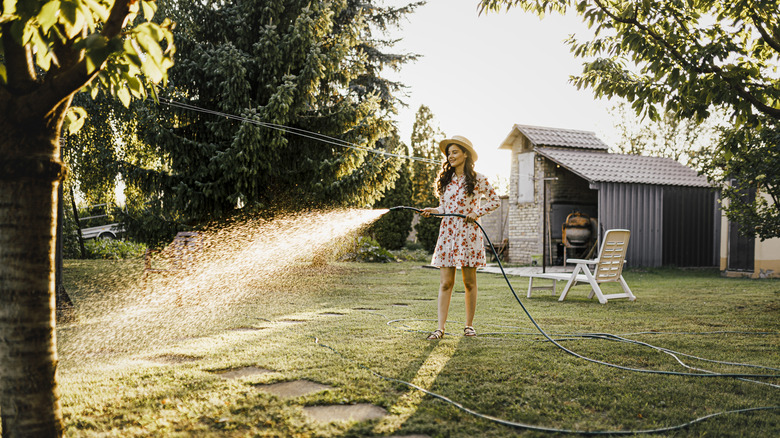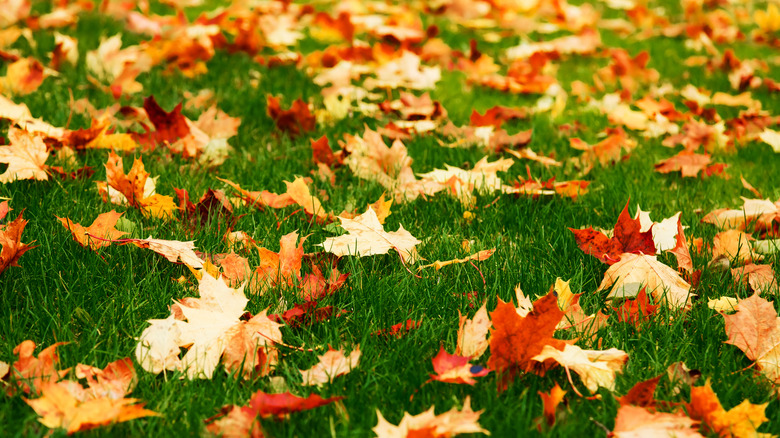The Best Time To Start Watering Your Lawn This Spring
When it comes to landscaping, even the most basic lawn requires some TLC to flourish. If you want to keep your lawn green with healthy grass that grows well, start with the basics. Namely, watering. A good watering regimen requires consistency and just the right amount of moisture. Do it too often and you'll make your grass prone to pests and disease. Not often enough and you'll dry out the soil, yellow the turf, and eventually kill your lawn. But before you get out the hose, it's important to consider when to begin watering in the spring.
As temperatures warm and winter turns to spring, you'll want to commit to a regular schedule –- just not too soon. If you live in a cooler climate, don't turn on the sprinklers immediately just because it's spring. Rather, wait until the grass has come out of its dormant state and started turning from brown back to green. If you're in a wet climate, let Mother Nature do the initial work for you — don't step in until most weeks are consistently warm and dry. You may even want to wait until the grass shows early signs of stress (i.e. wilting) before getting to work. Alternatively, if you're in a warm region where grass is watered year-round, keep your winter routine going until those high summer temps kick in. Then, once it's time to water proactively, you'll want to keep a few more things in mind.
The right watering strategy for your lawn
A grass lawn only needs about 1 inch of water each week – it should take an average sprinkler an hour to deliver the right quantity. You can do this in one go or split your watering routine into two 30-minute sessions. In order for your grass to develop strong roots that can withstand the hot, dry season, deep watering is key. Several daily short spurts leads to shallow root growth, meaning your grass won't be strong enough to flourish in the drier summer months.
Another important factor to keep in mind is when to water your lawn. You should do so early in the morning, ideally before 10 a.m. At this time, the sun is still low in the sky and temps haven't hit their max, which means the water won't evaporate as quickly as it would later in the day. This will allow more moisture to get to the roots where it's needed while also giving the blades time to fully dry as temperatures begin to rise. If grass stays moist for too long, it can become prone to fungus and rot.
If you're worried about watering too much or not enough, there are a few telltale signs to look out for. If the lawn feels mushy, is turning yellow or brown, or you're spotting loads of weeds, you're likely watering too much. Alternatively, if it's dry, patchy, and not growing like usual, you're probably under-watering.
What about all the other seasons?
When temperatures begin to rise and spring ushers in summer, you may find yourself reaching for the garden hose more often. Unfortunately, this is a common lawn maintenance mistake. Both warm and cool season grasses need no more than an inch of water a week, even during the summer — unless you live in an extremely hot and dry climate. If that's the case, check to see if your lawn is turning a dull green color or if your feet leave prints in the grass. If so, you may need to add an extra watering session. Consider upping your routine from 1 inch of water a week to 1 ½ inches, but only if it's regularly above 90 degrees Fahrenheit.
Another common lawn care mistake is to forget all about your lawn once autumn rolls around. After a hot summer, this is the time for your grass to get its strength back and recuperate. Continue watering with an inch per week, unless there's enough rainfall to allow you to take a break. A quick way to check if your lawn has enough moisture is to see if you can easily stick a screwdriver 6 inches into the soil.
Finally, once winter hits, your grass will likely go dormant and ½ inch of water a week will suffice. Meanwhile, folks in colder climates should stop altogether once it gets below 40 degrees Fahrenheit so as not to freeze and damage the lawn.


